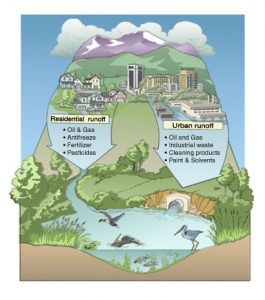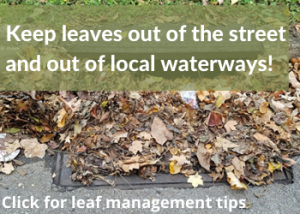There are two types of pollution that affect the quality of our watersheds:
1. Point source pollution
Point source pollution comes from an identifiable source, such as a factory or an industrial plant. Point source pollution is highly regulated through state and federal environmental laws. Most watershed pollution comes from non-point source pollution.
2. Non-point source pollution
Non-point source pollution comes from many different sources and cannot be traced to a single point. Non-point source pollution includes pollutants that are picked up by stormwater and drained into watersheds. Non-point source pollution includes:
Agricultural runoff
Pesticides, herbicides, fungicides, and other chemicals that farmers use for their crops or animals combine with the water that drains into the watersheds. These chemicals, in addition to animal waste, can lead to harmful bacteria polluting the water supplies.
Urban runoff
Urban runoff is also known as storm drain pollution. Rainwater drains from buildings, sidewalks, parking lots, lawns, and other urban areas and collects all the contaminants from those surfaces such as synthetic fertilizers, pesticides, grease, chemicals, animal droppings, etc. These pollutants drain into the storm drains and on to larger bodies of water without going through a treatment process first.
Urbanization
Urban development is a threat to watersheds because it changes water’s natural flow path. When areas near watersheds are developed, plants are replaced with impervious cover like roads, parking lots, sidewalks, driveways, and buildings, hindering the grounds ability to absorb stormwater. The resulting stormwater runoff actively erodes and contaminates streams and creeks when it carries the pollutants and debris it picks up as it flows.
Urbanization also leads to habitat degradation, vegetation removal, and more invasive species.
Septic sewage
According to the United States Environmental Protection Agency, an estimated 10 to 20 percent of onsite private waste water treatment systems malfunction each year, polluting the environment and causing public health risks. Contaminants from septic systems include bacteria and viruses, nutrient pollutants such as nitrates, and household chemicals that may have been disposed of down the drain or toilet. Proper septic system maintenance can prevent pollution.
For information on maintaining your septic system contact the McLean County Health Department or consult the EPA’s Septic Smart Program.






